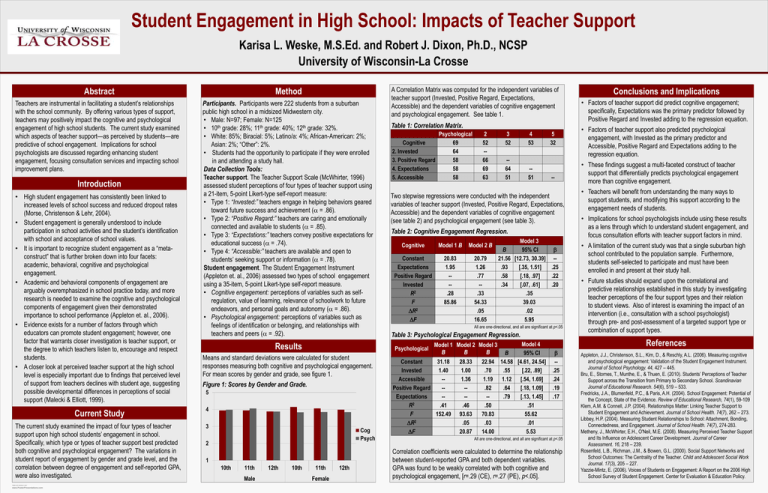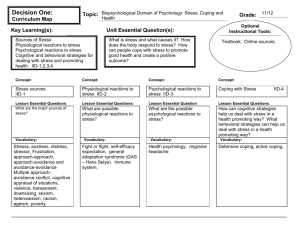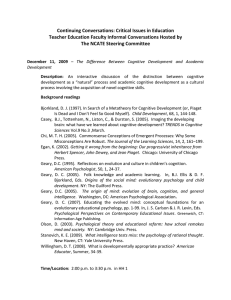• Factors of teacher support did predict cognitive engagement; Participants.
advertisement

Student Engagement in High School: Impacts of Teacher Support Karisa L. Weske, M.S.Ed. and Robert J. Dixon, Ph.D., NCSP University of Wisconsin-La Crosse Abstract Method Teachers are instrumental in facilitating a student’s relationships with the school community. By offering various types of support, teachers may positively impact the cognitive and psychological engagement of high school students. The current study examined which aspects of teacher support—as perceived by students—are predictive of school engagement. Implications for school psychologists are discussed regarding enhancing student engagement, focusing consultation services and impacting school improvement plans. Participants. Participants were 222 students from a suburban public high school in a midsized Midwestern city. • Male: N=97; Female: N=125 • 10th grade: 28%; 11th grade: 40%; 12th grade: 32%. • White: 85%; Biracial: 5%; Latino/a: 4%; African-American: 2%; Asian: 2%; “Other”: 2%. • Students had the opportunity to participate if they were enrolled in and attending a study hall. Data Collection Tools: Teacher support. The Teacher Support Scale (McWhirter, 1996) assessed student perceptions of four types of teacher support using a 21-item, 5-point Likert-type self-report measure: • Type 1: “Invested:” teachers engage in helping behaviors geared toward future success and achievement ( = .86). • Type 2: “Positive Regard:” teachers are caring and emotionally connected and available to students ( = .85). • Type 3: “Expectations:” teachers convey positive expectations for educational success ( = .74). • Type 4: “Accessible:” teachers are available and open to students’ seeking support or information ( = .78). Student engagement. The Student Engagement Instrument (Appleton et. al., 2006) assessed two types of school engagement using a 35-item, 5-point Likert-type self-report measure. • Cognitive engagement: perceptions of variables such as selfregulation, value of learning, relevance of schoolwork to future endeavors, and personal goals and autonomy ( = .86). • Psychological engagement: perceptions of variables such as feelings of identification or belonging, and relationships with teachers and peers ( = .92). Introduction • High student engagement has consistently been linked to increased levels of school success and reduced dropout rates (Morse, Christenson & Lehr, 2004). • Student engagement is generally understood to include participation in school activities and the student’s identification with school and acceptance of school values. • It is important to recognize student engagement as a “metaconstruct” that is further broken down into four facets: academic, behavioral, cognitive and psychological engagement. • Academic and behavioral components of engagement are arguably overemphasized in school practice today, and more research is needed to examine the cognitive and psychological components of engagement given their demonstrated importance to school performance (Appleton et. al., 2006). • Evidence exists for a number of factors through which educators can promote student engagement; however, one factor that warrants closer investigation is teacher support, or the degree to which teachers listen to, encourage and respect students. • A closer look at perceived teacher support at the high school level is especially important due to findings that perceived level of support from teachers declines with student age, suggesting possible developmental differences in perceptions of social support (Malecki & Elliott, 1999). Results Means and standard deviations were calculated for student responses measuring both cognitive and psychological engagement. For mean scores by gender and grade, see figure 1. Figure 1: Scores by Gender and Grade. 5 Current Study 4 The current study examined the impact of four types of teacher support upon high school students’ engagement in school. Specifically, which type or types of teacher support best predicted both cognitive and psychological engagement? The variations in student report of engagement by gender and grade level, and the correlation between degree of engagement and self-reported GPA, were also investigated. 3 TEMPLATE DESIGN © 2007 www.PosterPresentations.com Cog Psych 2 1 10th 11th Male 12th 10th 11th Female 12th A Correlation Matrix was computed for the independent variables of teacher support (Invested, Positive Regard, Expectations, Accessible) and the dependent variables of cognitive engagement and psychological engagement. See table 1. Table 1: Correlation Matrix. Psychological Cognitive 69 2. Invested 64 3. Positive Regard 58 4. Expectations 58 5. Accessible 58 2 52 -66 69 63 3 52 -64 51 4 53 -51 5 32 -- Two stepwise regressions were conducted with the independent variables of teacher support (Invested, Positive Regard, Expectations, Accessible) and the dependent variables of cognitive engagement (see table 2) and psychological engagement (see table 3). Table 2: Cognitive Engagement Regression. Cognitive Model 1 B Constant Expectations Positive Regard Invested R2 F R2 F 20.83 1.95 --.28 85.86 Model 3 Model 2 B B 95% CI 20.79 21.56 [12.73, 30.39] -1.26 .93 [.35, 1.51] .25 .77 .58 [.18, .97] .22 -.34 [.07, .61] .20 .33 .35 54.33 39.03 .05 .02 16.65 5.95 All are one-directional, and all are significant at p<.05 Table 3: Psychological Engagement Regression. Model 1 Model 2 Model 3 Psychological B B B Constant 31.18 Invested 1.40 Accessible -Positive Regard -Expectations -R2 .41 F 152.49 R2 F 28.33 1.00 1.36 --.46 93.63 .05 20.87 22.94 .70 1.19 .82 -.50 70.83 .03 14.00 Model 4 B 95% CI 14.58 [4.61, 24.54] .55 [.22, .89] 1.12 [.54, 1.69] .64 [.18, 1.09] .79 [.13, 1.45] .51 55.62 .01 5.53 Conclusions and Implications • Factors of teacher support did predict cognitive engagement; specifically, Expectations was the primary predictor followed by Positive Regard and Invested adding to the regression equation. • Factors of teacher support also predicted psychological engagement, with Invested as the primary predictor and Accessible, Positive Regard and Expectations adding to the regression equation. • These findings suggest a multi-faceted construct of teacher support that differentially predicts psychological engagement more than cognitive engagement. • Teachers will benefit from understanding the many ways to support students, and modifying this support according to the engagement needs of students. • Implications for school psychologists include using these results as a lens through which to understand student engagement, and focus consultation efforts with teacher support factors in mind. • A limitation of the current study was that a single suburban high school contributed to the population sample. Furthermore, students self-selected to participate and must have been enrolled in and present at their study hall. • Future studies should expand upon the correlational and predictive relationships established in this study by investigating teacher perceptions of the four support types and their relation to student views. Also of interest is examining the impact of an intervention (i.e., consultation with a school psychologist) through pre- and post-assessment of a targeted support type or combination of support types. References -.25 .24 .19 .17 All are one-directional, and all are significant at p<.05 Correlation coefficients were calculated to determine the relationship between student-reported GPA and both dependent variables. GPA was found to be weakly correlated with both cognitive and psychological engagement, [r=.29 (CE), r=.27 (PE), p<.05]. Appleton, J.J., Christenson, S.L., Kim, D., & Reschly, A.L. (2006). Measuring cognitive and psychological engagement: Validation of the Student Engagement Instrument. Journal of School Psychology. 44, 427 – 445. Bru, E., Stornes, T., Munthe, E., & Thuen, E. (2010). Students’ Perceptions of Teacher Support across the Transition from Primary to Secondary School. Scandinavian Journal of Educational Research. 54(6), 519 – 533. Fredricks, J.A., Blumenfeld, P.C., & Paris, A.H. (2004). School Engagement: Potential of the Concept, State of the Evidence. Review of Educational Research, 74(1), 59-109 Klem, A.M. & Connell, J.P. (2004). Relationships Matter: Linking Teacher Support to Student Engagement and Achievement. Journal of School Health. 74(7), 262 – 273. Libbey, H.P. (2004). Measuring Student Relationships to School: Attachment, Bonding, Connectedness, and Engagement. Journal of School Health. 74(7), 274-283. Metheny, J., McWhirter, E.H., O'Neil, M.E. (2008). Measuring Perceived Teacher Support and Its Influence on Adolescent Career Development. Journal of Career Assessment. 16, 218 – 239. Rosenfeld, L.B., Richman, J.M., & Bowen, G.L. (2000). Social Support Networks and School Outcomes: The Centrality of the Teacher. Child and Adolescent Social Work Journal. 17(3), 205 – 227. Yazzie-Mintz, E. (2006). Voices of Students on Engagement: A Report on the 2006 High School Survey of Student Engagement. Center for Evaluation & Education Policy.





